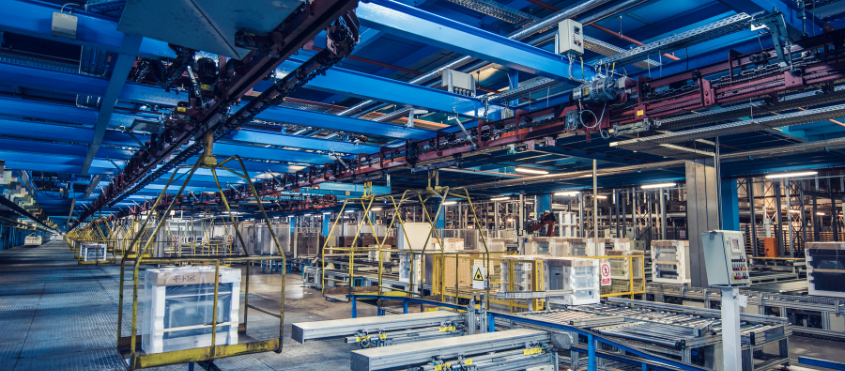
Related Articles

IT Outsourcing
RSK BSL Tech Team
May 4, 2025
|
|

Mobile Application Development
RSK BSL Tech Team
April 30, 2025
|
|

Software Development
RSK BSL Tech Team
April 27, 2025
|
|

Hire resources
RSK BSL Tech Team
April 24, 2025
|
|

Software Development
Praveen Joshi
April 20, 2025
|
|

Artificial Intelligence
Praveen Joshi
April 17, 2025
|
|

Pen Testing
Praveen Joshi
April 15, 2025
|
|

AI Tech Solutions
RSK BSL Tech Team
April 14, 2025
|
|

Software Development
RSK BSL Tech Team
April 9, 2025
|
|

Pen Testing
RSK BSL Tech Team
April 7, 2025
|
|

Software Development
RSK BSL Tech Team
April 3, 2025
|
|

Cloud Application
RSK BSL Tech Team
March 31, 2025
|
|

Pen Testing
Praveen Joshi
March 27, 2025
|
|

Software Development
RSK BSL Tech Team
March 25, 2025
|
|

Software Development
RSK BSL Tech Team
March 20, 2025
|
|

Software Development
RSK BSL Tech Team
March 18, 2025
|
Agile for Manufacturing: Optimizing Production Processes
Agile manufacturing is a manufacturing methodology that places an emphasis on being able to quickly meet changing customer demands, needs, creating a competitive advantage from speed, response, and agility.
As customers expect higher standards regarding delivery times and the customization of products and services, agile software development allows companies to take advantage of short windows of opportunity while also delivering more efficiently and flexibly than the competition.
How does it Work?
Agile manufacturing works by utilizing product design processes, technologies, close collaboration with the supply chain and corporate partners, staff training, and the involvement of the entire organization to respond quickly to market or consumer demands.
The following components are crucial to establishing an agile manufacturing foundation:
1. Product Design
As consumers demand a larger amount of personalised items and product iterations all delivered rapidly, an agile organisation is able to design production processes so that production schedules can meet any market demand variables.
2. Technologies
Responding to market demands requires technological support to allow an accurate, real-time flow of information between departments. With a shared database of parts, products, production capacities, and any problems, employee at any level are able to identify and resolve difficulties later in the production process, when they are less expensive.
3. Supply Chain / Partner Cooperation
An agile manufacturing operation requires strong business ties with its partners and suppliers. Suppliers will need to be kept up to date on production flow information to respond to the needs of end customers. Your supplier and related company network must be capable of responding if new agreements need to be negotiated, arrange material deliveries, update facilities, or other steps taken in response to customer demand. This collaboration implies that the agile manufacturer can rapidly boost the production of high-demand items and address redesigns to resolve difficulties or improve products.
4. Employee Training
With a shared database of parts, products, production capacities, and any problems, employee at any level are able to identify and resolve difficulties later in the production process, when they are less expensive. Employees must understand the reasons for changes to production schedules, designs, products, and have the ability to work in teams to solve problems or unanticipated challenges.
5. Company Involvement
To be genuinely agile, a company needs buy-in and involvement at all levels, which usually requires changes in organizational structures. The organization’s structure must encourage and empower teams to operate autonomously to satisfy demands, allowing employees to collaborate and use their expertise in a ‘bottom-up’ approach.
The key principles of agile manufacturing
1. Iteration
Perhaps the most important principle of agile in manufacturing is the iteration or the continuous improvement of products and processes. Iteration enables organizations to avoid the common error of investing too much time and money into a product or process that may not succeed. Small adjustments followed by testing help businesses lower the chance of failure while attaining their goals.
2. Bottom-up planning
Traditional manufacturing production typically begin with a high-level plan and proceed down to the details. In agile manufacturing, the process is reversed. Companies begin by focusing on the details and work their way up to the larger picture.
This bottom-up approach has several advantages:
- Allows organizations to be more responsive to changes by easily adjusting plans based on new information.
- helps companies use resources more efficiently since they can concentrate on what is important at any given moment.
- Encourages employees to take risks and voice their ideas as they have a better understanding of the situation.
3. Flexibility
To be truly agile, a manufacturing organization must be flexible in all aspects of its operation. This covers all aspects of the business, including the organizational structure, company culture, and the actual production process. This is especially relevant in an era of mass customization and high competition to maintain market share.
4. Augmentation
Finally, manufacturers need to be able to quickly and easily add new capabilities to their existing processes. This can entail including additional hardware, software, or personnel.
Conclusion
Agile manufacturing enables businesses to adjust to changing global circumstances or client expectations, staying ahead of the competition and at the top of customers’ minds. Agile software development services, which is centred around small, local teams, has the advantage of enabling quick response to customer demands for a variety of products, rapid product adaptation to changing requirements, and personalized solutions—all of which are challenging to achieve with large, remote manufacturing setups.
Praveen Joshi
Praveen is a seasoned IT Solutions Leader and Director at RSK Business Solutions, a technology-driven IT Consulting Company that specializes in Bespoke Software Development, Agile Consulting, Mobile App Development, Smart Sourcing, and much more. For the last 17 years, he has been delivering quality custom IT solutions that help businesses achieve their goals.

 Share
Share Post
Post Tweet
Tweet Copy
Copy


